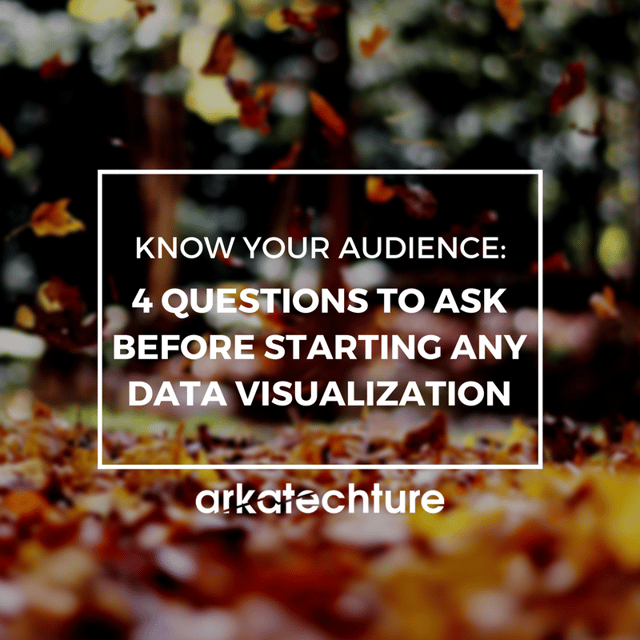Know Your Audience: 4 Questions To Ask Before Starting Any Data Visualization
by Amy Elliott, on August 4, 2016
There are so many technical aspects that go into creating a data visualization, ranging from exhausting data prep to reconciling advanced calculations. I'd like to argue that one of the most important aspects is not technical at all - it's knowing your audience. Your programming skills, art degree, or years of mastering a BI tool will not help here. You could create the da Vinci of dashboards, it could answer every business question you can think of, but if you design it for the wrong audience, its effectiveness will never be utilized.
To ensure that this never happens to any of your data visualizations, before you start any project, make sure you have exhausted the answers to these four questions:

What is The Business Context?
The answer to this question will form the foundation for the rest of your requirements gathering. Before you can design anything for anyone, you must have a firm grasp on why you are doing it. What problems are they looking to solve? How do these questions fit into larger ones or any overarching business initiatives. Once you think you understand, ask even more questions to be sure. Which department does this fit into? Do you have anything you currently use to answer these questions, can I look at those? Do you have any pre-conceived notions of what the findings of this analysis will be?
Who Will Use This?
So, who is your audience anyway? Knowing how to appeal to the primary users of your dashboards is critical. What level of analysis are they looking to do? Are you creating something for analysts that want to slice, dice, drill, further analyze, get to the bottom of many questions? You'll want to build a robust, analytical tool for them - several sets of interactive dashboards that enable a steady flow of analysis. In this case, they may want to see data at a more granular level - consider scatter plots, box and whisker, parameter-driven breakdowns where applicable.
On the other end of the spectrum, they might be looking for high-level numbers and light trending. This may be a manager who wants to check progress but isn't the one to get down to the lower level questions. In this case, the vizzer should have incredibly intuitive, lightly interactive dashboards with simpler chart types than in the case of an analyst. Suggested design elements would be large, high-level numbers and trending bar or line graphs.
What Are They Used to Seeing?
As vizzers develop more industry knowledge, it becomes easier to overlook how your user will want to see their data, and just always churn out reports that use only best practices. One of the biggest audiences we at Arkatechture run into are Excel/Crystal Report consumers. If you don't ask these questions and present them with a data visualization that is 100% best practice, I can guarantee you that 90% will have an negative initial reaction. Don't be fooled by "oh, that's pretty" or "that looks like what I know we should be doing," that doesn't mean they understand what they're looking at.
It's easy to get discouraged by these negative reactions, but think of it as a challenge. Meet people who are used to looking at "tabular" reports in the middle. There are several techniques to do that, one we use a lot is to make a best practice visualization, but then include a tabular view of the same data below it. When new to consuming visual dashboards, trust is often an issue and people don't trust bars and lines, they trust numbers. Once you show them that bars and lines match the numbers, then you can slowly start weaning them off of the numbers altogether and they will find the speed of analysis much faster. Form a good relationship with any stakeholders and be sure they are comfortable getting dashboards to a point where they will engage with them often.
How Will They Use This?
Now that you know who your user is, what they want and what they've had, you will need to consider how they will use the dashboards. When will they be most likely to get into the analysis flow and how often? This will let you know how frequently the data should be updated. Get to know their ideal scenario - will they pull the dashboard up every morning over a cup of coffee and stare at it? In this case, the visualization should be simple, to the point and able to be acted upon without much interaction. Will they be using it to cross-compare other reports, answer deeper questions? Will the questions vary? In this case, you will want the dashboards to be incredibly flexible to answer a multitude of questions and slice things any way may be pertinent.
Once you go through these questions a time or two, it becomes second nature. You'll find yourself getting fewer requests for design overhauls and more engagement with your dashboards. Once they reach high engagement, you have their attention and their trust and can start incorporating more best practices and more advanced visualization techniques - which every vizzer knows is the true way to measure progress!



